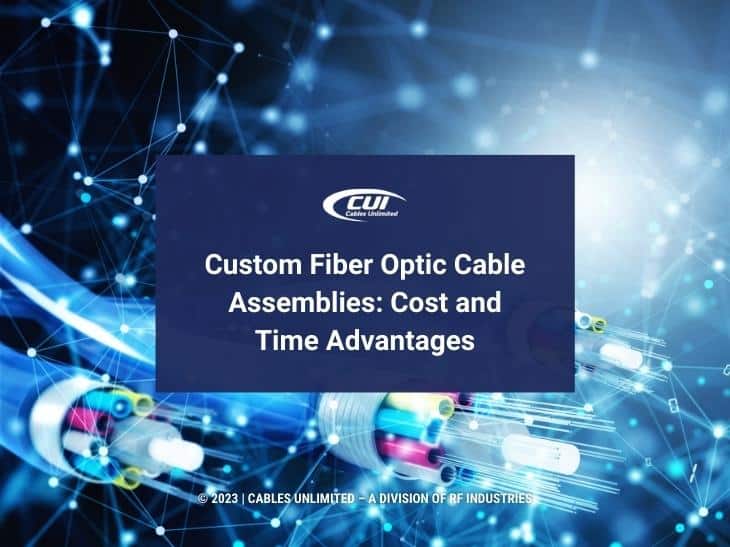The global fiber optics market is estimated at $4.9 billion in 2022, with an expected compound annual growth rate of 10.9%, reaching $8.2 billion by 2027. This is driven by the rising demand for higher bandwidths, expanding deployment of 5G infrastructure, and an ever-increasing number of data centers. This article defines fiber optic cable and custom fiber optic cable assemblies. It also examines their advantages and manufacturing requirements.
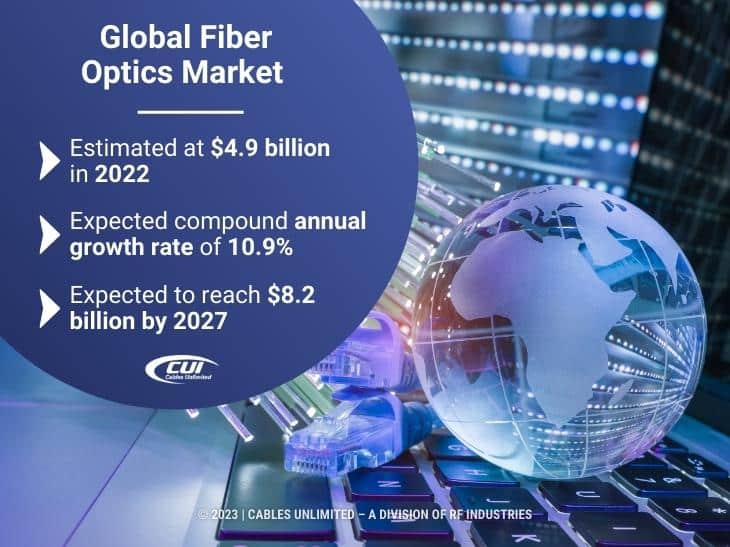
What Is a Fiber Optic Cable?
At its most basic form, fiber optic cables are thin strands of extremely pure glass fibers. Each fiber also has an internal cladding that bounces light inward to prevent signal loss. They transmit information using light from lasers or LEDs that are modulated with data or used, in some cases, as a light source.
There are three major types of fiber optic cables:
- Single Mode. This type of cable is used for long-distance network connections. It typically has a cable diameter of 9 microns, and just one wavelength of light can be transmitted. This minimizes attenuation due to decreased internal reflections.
- Multimode. This cable has a greater diameter running from 50 microns to 62.5 microns. It can handle several wavelengths of light and multiple signals. It’s used over shorter distances within a data center or local area network.
- Plastic. Plastic optical fibers, versus glass, typically have a diameter of 1 mm and allow a large number of signals. This also means that cheaper and less precise connectors can be used. They are used in small LANs over short distances.
Learn more in our article: Single-Mode Fiber: Why It’s the Go-To Solution for Enterprise Networks.
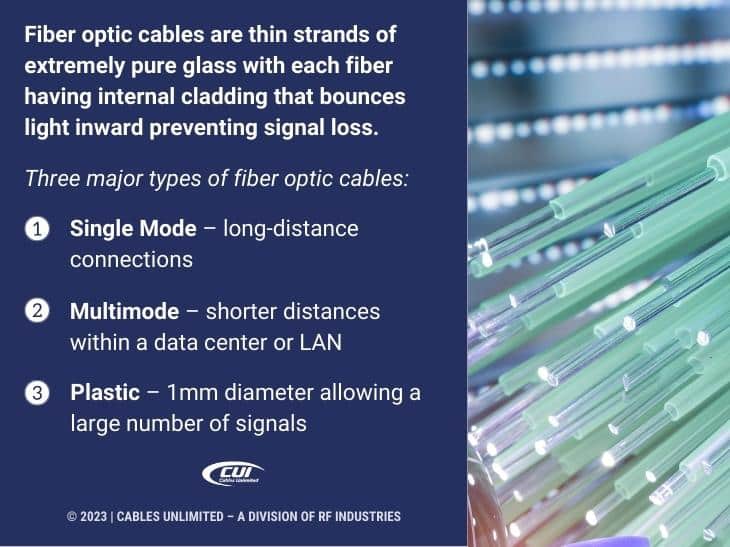
Advantages of Fiber Optic Cables
There are several significant advantages of using fiber optic cables.
- Faster Speed. The theoretical limit on fiber optics is the speed of light. In practice, they achieve up to 200 Gbps, while twisted pair copper is good at up to 10 Gbps.
- Wider Bandwidth. Fiber optic bandwidth is up to 4700 MHz for up to 80 km. Twisted pair copper wiring also achieves up to 4700 MHz but only up to 100 meters in length. Coaxial cable can reach a 750 MHz bandwidth of up to 500 meters.
- Lower Signal Loss. Copper cables have a signal loss that increases over distance. Fiber optic losses are present but at a much lower level.
- Lower Cost. Fiber optic cables are made from glass rather than much more expensive copper.
- Lighter Weight. Their glass construction means they are also far more lightweight than copper. Fiber weighs 4 pounds per 1,000 feet. Copper is almost 40 pounds for the same length.
- Thinner Diameter. Fiber cables are thinner. This allows installation in tight spaces and bundling of several fibers into a single cable.
- Longer Life Span. Fiber cables can be damaged by twisting or bending during installation. But once in place, it’s estimated that they can last for over 100 years.
- Greater Security. With fiber optics, the light signal is kept within the fiber. That means no radiation from the cable and radio frequency interference cannot enter the cable.
For more information, see our article titled Fiber Optics in the Future, It Only Gets Faster.
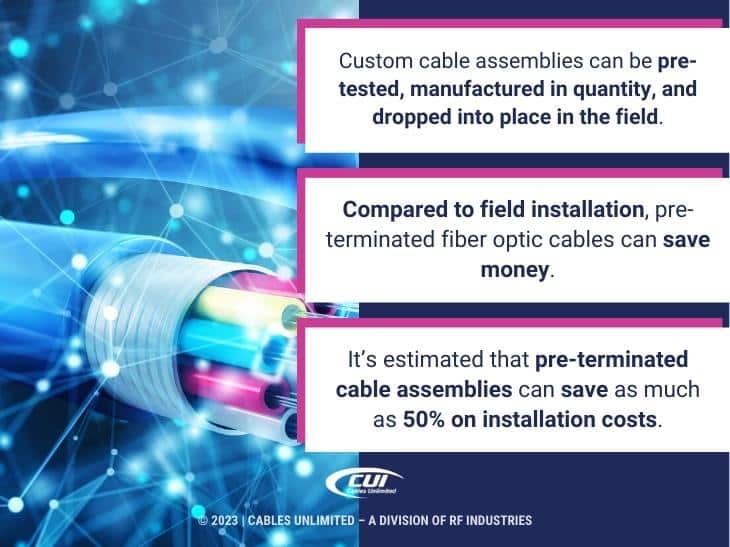
Advantages of Custom Fiber Optic Cable Assemblies
The significant advantages of custom cable assemblies are that they can be pre-tested, manufactured in quantity, and dropped into place in the field. Not only that, but compared to field installation, pre-terminated fiber optic cables can save money. Critical applications are fiber trunk cables in data centers, wire harnesses, and hybrid composite cables.
It’s estimated that pre-terminated cable assemblies can save as much as 50% on installation costs. In addition, since the termination is precision polished and tested at the factory, these procedures are not needed in the field. Plus, there’s no need for field testing equipment or consumables, further saving time and money.
That also allows faster installation and cable performance that’s already been measured. All that further reduces waste when cutting and trying cables and connectors in the field.
For more information, see our articles Cable & Wire Harnesses: Everything You Need to Know and Hybrid Cable Customization: Off-the-Shelf Cables Can’t Compete.
Custom Fiber Optic Cable Assembly Manufacturing and Testing Requirements
One of the significant advantages of custom fiber optic cable assemblies is that they can be manufactured and tested before they are installed in complex equipment. It’s far too costly to troubleshoot after the equipment is assembled.
The starting point for testing and manufacturing is the IPC/WHMA-A-620 standard. It provides every cable assembly manufacturer guidance on what is acceptable and what is considered defective. This standard goes into every detail, from insulation and crimps to connector installation. Our checklist includes: labeling, continuity, wire gauge measures, crimp analysis, insulation, and even pull tests looking for broken wires and short circuits.
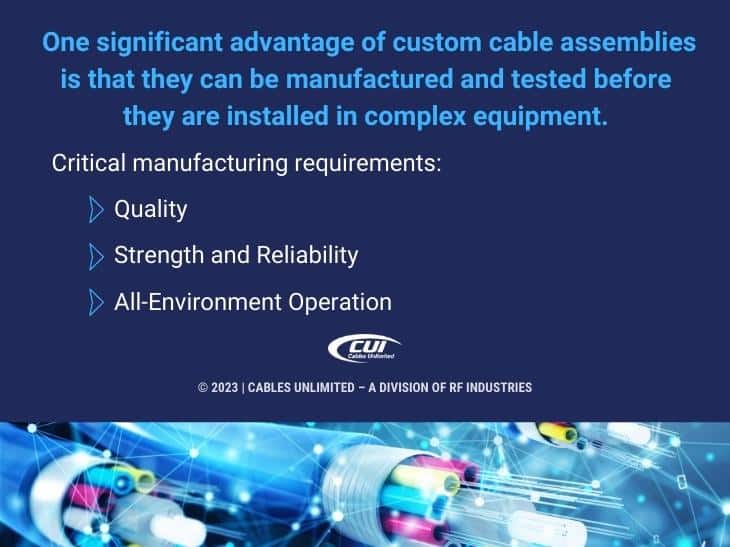
Here’s a quick list of the critical manufacturing requirements.
- Quality. A cable or connector failure can easily lead to failure in the field. That requires meeting specifications for high voltage, vibration, contact force, extreme temperatures, and more.
- Strength and Reliability. Strength and reliability testing can range from impact survival, vibration extremes, high pressure, abrasion, and wear.
- All-Environment Operation. From applications in the arctic and the desert, under the ocean, to space applications, custom cable assemblies need to handle it all and keep working.
We Can Help with Your Fiber Optic Cable Assembly Specification and Selection
We’ve got you covered for fiber optic cable assemblies.
If your requirements are already specified and ready for a quote for your current projects, we are prepared to meet your deadlines and pricing targets. Our extensive in-house services and advanced manufacturing capabilities are in place to meet your requirements.
But Cables-Unlimited offers much more than state-of-the-art manufacturing – our dedicated team is also known for going to great lengths to meet the needs of our customers, including working round-the-clock to meet tight turnaround time requirements.
Our sales representatives are standing by to assist you with product questions and quotes Monday – Friday, 8:00 am to 5:00 pm Eastern. Of course, you can also email us or complete our contact form, and we’ll get right back to you.

